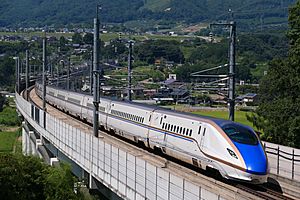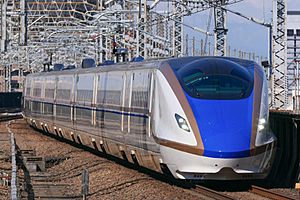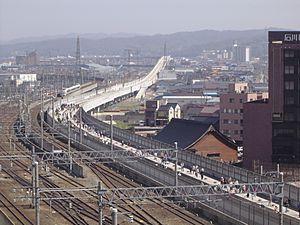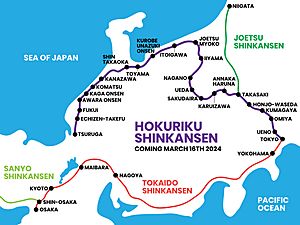Hokuriku Shinkansen facts for kids
Quick facts for kids Hokuriku Shinkansen |
|
|---|---|
 |
|

A JR East E7 series train on the Hokuriku Shinkansen
|
|
| Overview | |
| Native name | 北陸新幹線 |
| Status | Operational |
| Owner | |
| Locale | Tokyo, Saitama, Gunma, Nagano, Niigata, Toyama, Ishikawa, and Fukui Prefectures |
| Termini | Takasaki Tsuruga |
| Stations | 24 |
| Color on map |
|
| Service | |
| Type | High-speed rail (Shinkansen) |
| System | Shinkansen |
| Services | Kagayaki, Hakutaka, Tsurugi, Asama |
| Operator(s) | |
| Depot(s) | Nagano, Hakusan |
| Rolling stock | E7 series, W7 series |
| History | |
| Opened | 1 October 1997 |
| Last extension | 16 March 2024 |
| Technical | |
| Line length | 574.7 km (357.1 mi) |
| Number of tracks | Double-track |
| Track gauge | 1,435 mm (4 ft 8 1⁄2 in) standard gauge |
| Minimum radius | 4,000 m (2.5 mi; 13,000 ft) |
| Electrification | 25 kV AC, 50/60 Hz (overhead line) |
| Operating speed | 260 km/h (162 mph) |
| Signalling | Cab signalling |
| Train protection system | DS-ATC |
| Maximum incline | 3.0% |
The Hokuriku Shinkansen (Japanese: 北陸新幹線) is a super-fast train line in Japan. It connects Tokyo with Tsuruga in the Hokuriku region. This important line is run by two different companies: East Japan Railway Company (JR East) and West Japan Railway Company (JR West).
The first part of the line, between Takasaki and Nagano, opened on October 1, 1997. This was just in time for the 1998 Winter Olympics in Nagano. Back then, it was called the Nagano Shinkansen. Later, the line was extended to Toyama and Kanazawa, opening on March 14, 2015. The newest section, stretching 125 kilometers to Fukui and Tsuruga, opened on March 16, 2024. There are plans to extend the line even further to Shin-Osaka in the future.
Contents
Train Services and Names
Since March 2015, there are four main types of train services on the Hokuriku Shinkansen. These trains also use parts of the Joetsu and Tohoku Shinkansen lines between Tokyo and Takasaki.
- Kagayaki: This is a super-fast train that makes very few stops. It travels all the way from Tokyo to Tsuruga.
- Hakutaka: This train also goes from Tokyo to Tsuruga, but it stops at most stations along the way.
- Tsurugi: This is a shuttle train service that runs between Toyama and Tsuruga, stopping at all stations.
- Asama: These trains travel between Tokyo and Nagano. They usually stop at most stations, just like the original Nagano Shinkansen service from 1997.
The Asama trains from 1997 replaced older, slower trains. Back then, a trip from Tokyo to Nagano took about 2 hours and 50 minutes. Now, the fastest trip from Tokyo to Tsuruga is 3 hours and 8 minutes. This is 50 minutes faster than before!
Stations Along the Line
Here's a guide to how trains stop at stations:
| ● | All trains stop here. |
|---|---|
| ▲ | Some trains stop here. |
| | | All trains pass through without stopping. |
| Line | Station | Japanese Name | Distance (km) | Asama | Kagayaki | Hakutaka | Tsurugi | Other Train Lines | Location | |
|---|---|---|---|---|---|---|---|---|---|---|
| Tohoku Shinkansen |
Tokyo | 東京 | 0.0 | ● | ● | ● |
|
Chiyoda | Tokyo | |
| Ueno | 上野 | 3.6 | ● | ▲ | ● |
|
Taitō | |||
| Ōmiya | 大宮 | 31.3 | ● | ● | ● |
|
Ōmiya-ku, Saitama | Saitama Prefecture | ||
| Joetsu Shinkansen |
Kumagaya | 熊谷 | 67.9 | ▲ | | | | | Kumagaya | |||
| Honjō-Waseda | 本庄早稲田 | 88.0 | ▲ | | | | | Honjō | ||||
| Hokuriku Shinkansen |
Takasaki | 高崎 | 108.6 | ● | ● | ▲ | Takasaki | Gunma | ||
| Annaka-Haruna | 安中榛名 | 127.1 | ▲ | | | | | Annaka | ||||
| Karuizawa | 軽井沢 | 150.4 | ● | | | ▲ | Karuizawa, Kitasaku | Nagano | |||
| Sakudaira | 佐久平 | 168.0 | ▲ | | | ▲ |
|
Saku | |||
| Ueda | 上田 | 192.8 | ▲ | | | ▲ | Ueda | ||||
| Nagano | 長野 | 226.0 | ● | ● | ● | Nagano | ||||
| Iiyama | 飯山 | 255.9 | | | ▲ |
|
Iiyama | ||||
| Jōetsumyōkō | 上越妙高 | 285.5 | | | ● | Jōetsu | Niigata | ||||
| Itoigawa | 糸魚川 | 322.5 | | | ● | Itoigawa | |||||
| Kurobe-Unazukionsen | 黒部宇奈月温泉 | 361.7 | | | ● |
|
Kurobe | Toyama | |||
| Toyama | 富山 | 395.5 | ● | ● | ● | Toyama | ||||
| Shin-Takaoka | 新高岡 | 414.4 | | | ● | ● |
|
Takaoka | |||
| Kanazawa | 金沢 | 454.0 | ● | ● | ● | Kanazawa | Ishikawa | |||
| Komatsu | 小松 | 481.2 | ▲ | ● | ▲ | Komatsu | ||||
| Kagaonsen | 加賀温泉 | 495.8 | ▲ | ● | ▲ | Kaga | ||||
| Awaraonsen | 芦原温泉 | 512.0 | ▲ | ● | ▲ | Awara | Fukui | |||
| Fukui | 福井 | 530.0 | ● | ● | ● | Fukui | ||||
| Echizen-Takefu | 越前たけふ | 549.0 | ▲ | ● | ▲ | Echizen | ||||
| Tsuruga | 敦賀 | 574.7 | ● | ● | ● | Tsuruga | ||||
| Plans for future stations are being reviewed. | ||||||||||
| Hokuriku Shinkansen |
Higashi-Obama | 東小浜 |
|
Obama | Fukui | |||||
| Kyōto | 京都 |
|
Shimogyo-ku, Kyoto | Kyoto | ||||||
| Matsuiyamate | 松井山手 | Kyōtanabe | ||||||||
| Shin-Ōsaka | 新大阪 |
|
Yodogawa-ku, Osaka | Osaka | ||||||
- The point where JR East and JR West take over the line is just north of Jōetsumyōkō Station.
- Stations written in italics are not yet open.
Trains Used on the Line
The Hokuriku Shinkansen uses two main types of trains:
- E7 series (12-car "F" sets) - These trains have been used since March 2014.
- W7 series (12-car "W" sets) - These trains started running in March 2015.
When the Nagano Shinkansen first opened, it used E2 series trains. Later, the newer E7 series trains were brought in, followed by the W7 series trains. The E2 series trains were completely removed from the Hokuriku Shinkansen line by March 2017.
In 2019, a big typhoon called Typhoon Hagibis caused flooding in Nagano. This damaged ten trains, which was a big loss for the railway companies.
Older Trains Used in the Past
Some other trains were used on the line before:
- E2 series (8-car "N" sets) - Used only for Asama services between Tokyo and Nagano.
- E2 series (8-car "J" sets)
- E4 series (8-car "P50/P80" sets) - Known as Max Asama.
- 200 series (12-car set F80) - Used only for a short time in February 1998.
The 200 series F80 train was special. It was changed to work with different power systems and to handle the steep slopes on the Nagano Shinkansen. It could go up to 210 kilometers per hour.
History of the Line
How the Nagano Shinkansen Started
The first part of the line, from Takasaki to Nagano, opened on October 1, 1997. This was a big help for the 1998 Winter Olympics held in Nagano.
Between 2012 and 2014, station platforms were made longer to fit the new 12-car E7 series trains. This was in preparation for the line's extension beyond Nagano. The extension from Nagano to Kanazawa opened in March 2015. The next part, from Kanazawa to Tsuruga, was approved for building in 2012 and opened on March 16, 2024.
Naming the Line
The official name of the line has always been Hokuriku Shinkansen. However, when the Nagano section first opened, JR East decided not to use "Hokuriku Shinkansen" for passengers. This was because the main way for people from Tokyo to get to the Hokuriku region was to take a different Shinkansen line and then switch trains.
Local governments in the Hokuriku region wanted the name "Hokuriku" to be used. They were worried that if the name wasn't used, the rest of the line might not get built.
So, in July 1997, JR East came up with a solution:
- Train announcements would say "Nagano Shinkansen".
- Signs in Tokyo would say "Nagano-bound Shinkansen".
- Stations between Annaka-Haruna and Nagano would just say "Shinkansen".
Eventually, "Nagano-bound Shinkansen" was dropped, and "Nagano Shinkansen" became common. Once the extension to Kanazawa was confirmed, the arguments about the name became less important.
Extending Beyond Nagano
The extension from Nagano to Kanazawa was finished in May 2014. When trains started running in March 2015, the travel time from Tokyo to Toyama became about 2 hours. Kanazawa was just 30 minutes further. Permission to start building to Fukui was given in December 2011. The extension to Tsuruga opened on March 16, 2024. After Jōetsumyōkō Station, West Japan Railway Company (JR West) takes over running the line from East Japan Railway Company (JR East).
The Naming Discussion Returns
When the Nagano–Kanazawa section was about to open, people started discussing the line's name again. Some groups in Nagano wanted to keep "Nagano–Hokuriku Shinkansen" to avoid confusing passengers. But officials in the Hokuriku region insisted on using the official name, "Hokuriku Shinkansen."
JR West, which runs the section west of Jōetsumyōkō, simply used "Hokuriku Shinkansen." On October 2, 2013, JR East announced that the official name would indeed be Hokuriku Shinkansen. They added "(via Nagano)" to make it clear how the line runs.
Testing the New Sections
Testing on the JR East part of the line between Nagano and Kurobe-Unazukionsen began in December 2013. Special test trains, like the "East i", were used. They started at low speeds and gradually increased to the full speed of 260 kilometers per hour. Testing continued until March 2014.
Testing on the whole line between Nagano and Kanazawa started in August 2014. W7 series trains also began testing in August 2014 on the JR West section.
The Tsuruga Extension Opens
JR West did many low-speed tests on the new Kanazawa-Tsuruga section in late 2023. Regular W7 series trains started testing in September. Passenger service officially began on March 16, 2024. There were special events in Tsuruga and Tokyo to celebrate.
Because of this extension, the "Thunderbird" express train service stopped running between Tsuruga and Kanazawa on March 15, 2024.
Future Plans for the Line
The plan for the final section from Tsuruga to Ōsaka was decided on December 20, 2016. It will follow the 'Obama–Kyoto' route. Several routes were considered:
- Maibara Route: This would have been shorter but would have used already busy tracks near Osaka.
- Kosei Route: This was the cheapest option, using existing lines. However, trains would have been slower.
- Obama Route: This was the shortest route to Osaka but very expensive. It would have bypassed Kyoto.
- Obama–Kyoto Route: This is the chosen route. It goes through Obama and then connects to the Tokaido Shinkansen at Kyoto. Including Kyoto is important for tourism.
- Maizuru Route: This was a politician's idea, going through Maizuru. It would have been very expensive but aimed to help develop the Maizuru area.
In March 2017, the government decided the route from Kyoto to Shin-Osaka would go through Kyotanabe, with a station at Matsuiyamate.
Past Interim Plans
Before the full line to Shin-Osaka is built, JR West looked into using special "Gauge Change Trains" (GCT). These trains could switch between different track widths. The idea was for them to run on both the Shinkansen tracks and older, narrower tracks. This would have allowed trains to go directly from Tsuruga to Osaka. However, in August 2018, JR West decided not to use these special trains for this route.
Local Lines Affected by the Shinkansen
When the Nagano Shinkansen first opened in 1997, a section of the older Shinetsu Main Line was transferred to a new company called Shinano Railway. This became the Shinano Railway Line.
When the Hokuriku Shinkansen extended north of Nagano in March 2015, more older train lines were transferred. These lines, which run parallel to the Shinkansen, are now run by new local companies. This included parts of the Shinetsu Main Line and the Hokuriku Main Line.
In 2019, it was decided that another section of the Hokuriku Main Line, between Tsuruga and Fukui, would also be transferred. This section is now split between two new companies: IR Ishikawa Railway and Hapi-Line Fukui. Hapi-Line Fukui took over its section on March 16, 2024.
| Old Line Name | Old Company | Date Changed | Section | Length (km) | New Line Name | New Company |
|---|---|---|---|---|---|---|
| Shinetsu Main Line | JR East | 1 October 1997 | Karuizawa–Shinonoi | 65.1 | Shinano Railway Line | Shinano Railway |
| 14 March 2015 | Nagano–Myōkō-Kōgen | 37.3 | Shinano Railway Kita-Shinano Line | |||
| Myōkō-Kōgen–Naoetsu | 37.7 | Myōkō Haneuma Line | Echigo Tokimeki Railway | |||
| Hokuriku Main Line | JR West | Naoetsu–Ichiburi | 59.3 | Nihonkai Hisui Line | ||
| Ichiburi–Kurikara | 100.1 | Ainokaze Toyama Railway Line | Ainokaze Toyama Railway | |||
| Kurikara–Kanazawa | 17.8 | IR Ishikawa Railway Line | IR Ishikawa Railway | |||
| 16 March 2024 | Kanazawa–Daishōji | 46.4 | ||||
| Daishōji–Tsuruga | 84.3 | Fukui Line | Hapi-Line Fukui |
Images for kids









